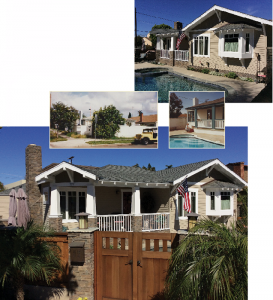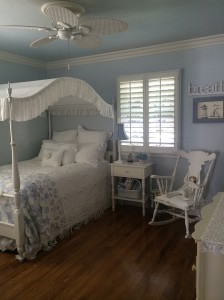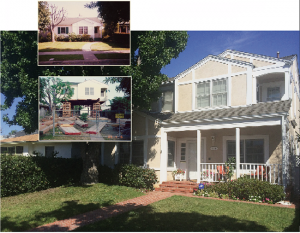Peppered around the island, nestled among new construction, are several Palmer-Bilt homes — 154 of which were built in the early 1940s to house workers in war-related industries. Many of them still stand today — some with the original footprint both inside and out, others with new additions and design.
Palmer homes were designed in Minimal Traditional style, made popular during the Great Depression until the early 1950s. The structures, most of which were around 1,000 square feet, had three bedrooms and one bathroom surrounding a central utility closet that held the home’s furnace and water heater. The homes had a fireplace in the living room, stucco exteriors, and no dining room. Coronado architect Dorothy Howard explained that the homes were an early version of tract housing — which were being built all over the country at the time — with a style particular to Southern California. In 1944 they cost $4,000 to build; in July an original Palmer on F Avenue sold for $1.28 million. “Palmer homes have a really efficient design and use of space,” said Howard. “They are structurally simple and many of them are still standing — and standing well.”
Lorraine Boulanger can attest to that. She moved to Coronado from Connecticut in 1998 and bought a 1944 Palmer home on J Avenue. “These are such well-built little houses,” she said. Boulanger also appreciates that the homes are built on a raised foundation and were ahead of their time in terms of building standards, including earthquake codes. There’s also a garage on the back of the property, which was added in 1946 for $400.
Boulanger’s home is such an appealing little slice of history that the Coronado Historical Association featured it this year as one of the homes on their annual historic home tour.
Boulanger affectionately refers to her block as “Palmer Row,” noting that every house surrounding her is a Palmer, many of them maintaining, like hers, the original footprint of the home.
Boulanger surmises the area’s preponderance of Palmers was because of its proximity to Naval Air Station North Island, where workers in the war industry could qualify to buy the modest homes with Federal Housing Administration financing; Howard has a slightly different theory.
Howard noted that many Palmer homes were built in the northwest quadrant of the city, many on H, I and J avenues. While Palmer-Bilt homes weren’t exactly tract homes (a concept which didn’t exist in the 1940s), “This was an area of town that had lots of space available,” she said. “Most of the higher-end custom homes were built at the opposite end of town at the time, closer to the Hotel del Coronado and shopping district. In this more open area of town, a builder could construct several homes at the same time and keep an eye on them all, moving from house to house to house.”
Boulanger has added a number of special touches that pack a lot of charming punch to her home. A welcoming white pergola defines a dining and gathering area in the backyard, opposite a pool. Plantation shutters and canvas awnings add charm to the the streetscape and backyard.
Inside, she turned the utility closet into a pantry and painted each room in bright, pastel colors. She added crown molding, wainscoting throughout the home and finished the ceilings with beadboard. Bedrooms feature opaque glass-paned doors that let natural light shine through to interiors, while maintaining privacy.
Perhaps the biggest change was in the kitchen, where Boulanger added counter space and drawers and cut the full wall separating the kitchen from the living room into a half wall, creating a banquette dining area and a more open-concept floor plan. “It’s a perfect place to sit and play games or chat with friends,” she said.
“I love that everything is on one floor and upkeep is minimal,” Boulanger said. “In my time of life, you don’t want something big.”
Realtors have visited Boulanger’s home from time to time and given her the nod of approval on her renovation work.
“They said I’ve fixed it up the way it should have been fixed up — as a cottage,” she said. “That was easy to do — all the bones were there.”
Boulanger concedes that the original layout, which worked out fine for a family of five in the 1940s, would be a bit crowded for today’s family. “Today, I think they’re ideal for a single person or a couple.”
Howard agrees, noting that there aren’t many Palmers left that haven’t had something done to them. “Three bedrooms and only one bathroom is not as functional by today’s standards. I’ve seen a lot of people convert the utility closet into a second bathroom, or raise the whole house and build a new first floor. The Palmer’s structural simplicity makes them easy to remodel. By raising these ‘small rooms’ to the top, they can be readily adapted to bedrooms; then you can add larger more open rooms on the first floor.”
That’s the approach that Art and Dana Wilcox took, when they turned to Coronado architect Donna Crossman to remodel their Palmer on H Avenue in 1989. “Art realized they had a perfectly good house — so why redo it completely?” Crossman said. The construction crew elevated the house and suspended it while building a new foundation and first floor, then set the original house on top as a second story. “We were one of the first houses in the neighborhood to add a second story at the time,” said Art. “We knew that by keeping the original home as part of the remodel, we’d be able to preserve the look and character of the neighborhood — that was important to us,” he said.
As the construction team lifted the house, they quickly learned that the original central utility closet sat atop a solid block of concrete. “We laugh looking back on that realization,” said Crossman. “We had to rush to reinforce it but everything was fine,” she said. Taking this approach — despite surprising slabs of concrete — allowed the Wilcoxes to preserve much of the historical home — including the original wood flooring.
For the second story, the Wilcoxes turned the original living room into the master bedroom and adapted the kitchen, already fully plumbed, into the adjacent master bath.
In the all-new first floor, they incorporated traditional Palmer elements such as built-in cabinets and decorative casings around all the doors and windows. “All the Palmer homes I’ve worked on had this unique style of casing throughout the home — sort of a concave design — It’s a definite style that you don’t see much anymore, but to me, those accents are what make a Palmer,” Crossman said. They also re-created the central core by building the staircase in the center of the home.
Just a block away is another Palmer home that’s gotten new life. Ken and Beth Slanie bought the little home — in need of much TLC — on the corner of I Avenue and Sixth Street in 1992. Ken, a general contractor, redesigned the home in 2013 and, in just seven months, took it from a 950-square-foot Palmer home to a 1,450-square-foot Craftsman. “At first I planned on adding a second story,” he said. “But then I figured I’d rather avoid the hassle. So we stuck with an open floor plan. We pretty much opened up the whole living space between the dining room and kitchen, so you can be having a snack on one side of the house and watching football on the other!”
The Slanies reconfigured the floorplan so the home now has two bedrooms and two bathrooms, adding 500 square feet to the back of the home to create a large master suite. While keeping the original wood floors, they added Craftsman-style elements including custom cabinetry and doors, three-step inverted ceilings, and arched interior doorways. On the exterior, the Slanies stripped the stucco and added horizontal lap siding — a classic Craftsman trait. They extended the porch to the corner of the house, and added a pop-out window to create a breakfast nook.
Slanie’s design was nominated this year for a Coronado GEM (Going the Extra Mile) Award, created by the Coronado Historical Association to recognize renovations that best reflect the island’s history and character.
Palmer-Bilt homes may now be in their golden years — 71 years and counting — but for many of the residences (and their residents) this adage holds true: “They’re not getting older; they’re getting better.”






